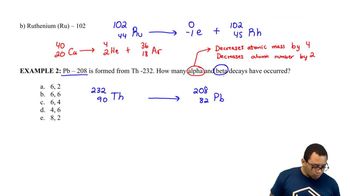Textbook Question
Complete each of the following nuclear equations and describe the type of radiation:
e. 18880Hg → ? + 0+1e
 Verified step by step guidance
Verified step by step guidance Verified video answer for a similar problem:
Verified video answer for a similar problem:



 1:54m
1:54mMaster Positron Emission Concept 1 with a bite sized video explanation from Jules
Start learning